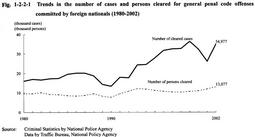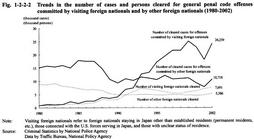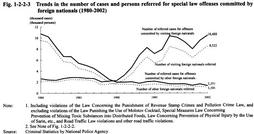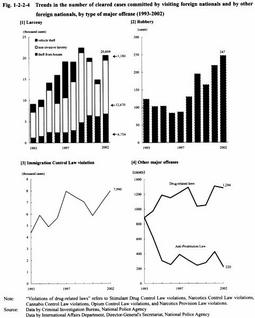| Previous Next Index Image Index Year Selection | |
|
|
2 Trends in crimes by foreign nationals (1) Outline Fig. 1-2-2-1 shows the number of cases and persons cleared for general penal code offenses committed by foreign nationals since 1980.
Fig. 1-2-2-1 Trends in the number of cases and persons cleared for general penal code offenses committed by foreign nationals (1980-2002) The cleared cases for general penal code offenses committed by foreign nationals temporarily decreased after peaking in 1999, but increased significantly from the previous year to 34,977 in 2002. The number of foreign nationals cleared has increased gradually since 1998, reaching a record high of 13,077 in 2002. In 2002, the total number of persons cleared for general penal code offenses was 347,880, 3.8% of which were foreign nationals (up 0.1 point from the previous year).Fig. 1-2-2-2 shows the numbers of cases cleared and persons cleared for general penal code offenses committed by visiting foreign nationals and by other foreign nationals since 1980. Visiting foreign nationals are defined, in the Criminal Statistics by the National Policy Agency, as foreign nationals staying in Japan other than established residents (permanent residents, etc.), those connected with the U.S. forces serving in Japan, and those with unclear status of residence (hereinafter the same in this section). The cases and persons cleared for general penal code offenses committed by visiting foreign nationals have increased significantly since 1980. Visiting foreign nationals have exceeded other foreign nationals in the number of persons cleared since 1991 and in the number of cleared cases since 1993. In 2002, the cleared cases for general penal code offenses committed by visiting foreign nationals increased by 6,060 (33.3%) from the previous year to 24,259, reaching the second largest figure following the record high marked in 1999. The number of visiting foreign nationals cleared also increased by 523 (7.3%) from the previous year, reaching a record high of 7,691. Fig. 1-2-2-2 Trends in the number of cases and persons cleared for general penal code offenses committed by visiting foreign nationals and by other foreign nationals (1980-2002) Fig. 1-2-2-3 shows the number of cases and persons referred for special law offenses excluding violations of traffic-related laws committed by visiting foreign nationals and by other foreign nationals since 1980.The cases and persons referred for offenses committed by other foreign nationals continued to decrease until 1990 and remained almost flat since then whereas those cases and persons committed by visiting foreign nationals have been on the rise; visiting foreign nationals have exceeded other foreign nationals both in the cases and persons referred in 1990, accounting for a majority of the cases and persons referred. In 2002, the cases and persons referred for special law offenses committed by visiting foreign nationals reached record highs of 10,488 and 8,522 respectively. Fig. 1-2-2-3 Trends in the number of cases and persons referred for special law offenses committed by foreign nationals (1980-2002) (2) Trends in offenses by type of offense This subsection outlines the trends in major types of offenses committed by visiting foreign nationals.
Fig. 1-2-2-4[1] shows the trends in the number of cleared cases for larceny committed by visiting foreign nationals over the last 10 years. The cleared cases for larceny continued to rise until it peaked in 1999, and then decreased for 2 years. In 2002, they increased sharply by 5,781 (39.0%) from the previous year to 20,604. By modus operandi, the number for vehicle theft has been small in recent years and the number for non-invasive theft has fluctuated significantly whereas the number for theft from houses has risen remarkably by 607 (9.9%) from the previous year to 6,754 in 2002. Fig. 1-2-2-4[2] shows the trends in the number of cleared cases for robbery committed by visiting foreign nationals over the last 10 years. In 2002, it reached a record high of 247. Fig. 1-2-2-4[3] shows the trends in the number of cleared cases for Immigration Control Law violations committed by visiting foreign nationals over the last 10 years. The cases for Immigration Control Law violations temporarily declined after a peak in 1997, but started to rise again in 2001 and increased by 1,032 from the previous year to a record high of 7,990 in 2002. By type of violation, the illegal overstay was the largest with 4,122 cases, followed by non-possession of passports/refusal to show passports with 1,739 cases, illegal stay with 1,318 cases, and illegal entry with 470 cases. The cases for the offense of illegal stay, which was newly established upon the amendment to the Immigration Control Law in 1999 (entry into force in February 2000) have increased from 296 in 2000 to 1,011 in 2001 and 1,318 in 2002 (Source: Data by International Affairs Department, Director-General's Secretariat, National Police Agency). This was one of the factors for the increase of Immigration Control Law violations. The number of persons cleared by the police or Maritime Safety Agency for group stowaway incidents rose sharply from 324 in 1995 to 679 in 1996 and 1,360 in 1997, and then took a downward turn and fell to 170 in 2002 (Source: Data by International Affairs Department, Director-General's Secretariat, National Police Agency). This may be due to the amendment to the Immigration Control Law in May 1997 (entry into force in the same month). Upon this amendment, for the purpose of responding to the sharp increase of group stowaway incidents in which international group agents such as "Snakeheads" were involved, the offense of group stowaway was newly established and regulations against those who encourage or support group stowaway was tightened. The number of persons referred for group stowaway has fluctuated from 38 in 1997 to 153 in 1998, 142 in 1999, 29 in 2000, 58 in 2001, and 42 in 2002 (Source: Data by Criminal Statistics by National Police Agency). Fig. 1-2-2-4[4] shows the trends in the number of cleared cases for violations of drug-related laws and Anti-Prostitution Law committed by visiting foreign nationals over the last 10 years. The cases for violations of drug-related laws have been over 1,000 since 1995, marking 1,284 in 2002. The cases for Anti-Prostitution Law violations were 220 in 2002. Fig. 1-2-2-4 Trends in the number of cleared cases committed by visiting foreign nationals and by other foreign nationals, by type of major offense (1993-2002) |



